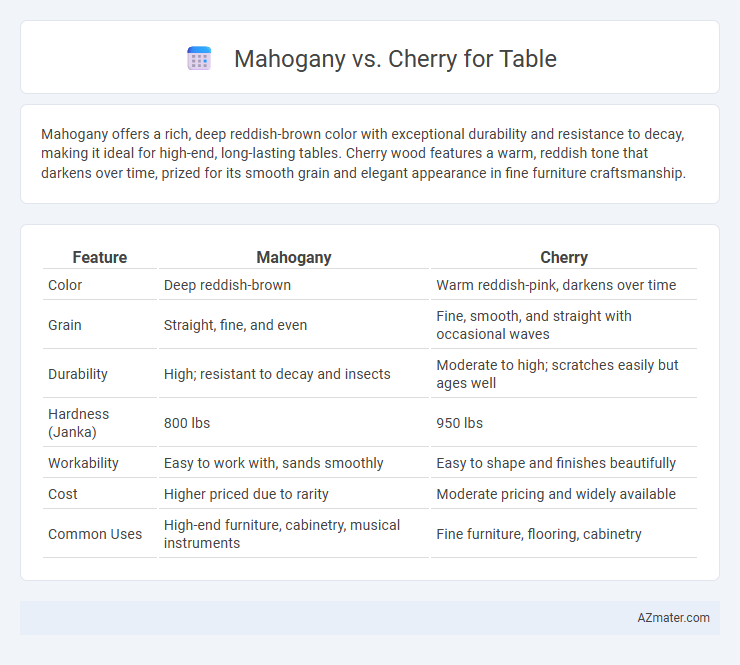Mahogany offers a rich, deep reddish-brown color with exceptional durability and resistance to decay, making it ideal for high-end, long-lasting tables. Cherry wood features a warm, reddish tone that darkens over time, prized for its smooth grain and elegant appearance in fine furniture craftsmanship.
Table of Comparison
| Feature | Mahogany | Cherry |
|---|---|---|
| Color | Deep reddish-brown | Warm reddish-pink, darkens over time |
| Grain | Straight, fine, and even | Fine, smooth, and straight with occasional waves |
| Durability | High; resistant to decay and insects | Moderate to high; scratches easily but ages well |
| Hardness (Janka) | 800 lbs | 950 lbs |
| Workability | Easy to work with, sands smoothly | Easy to shape and finishes beautifully |
| Cost | Higher priced due to rarity | Moderate pricing and widely available |
| Common Uses | High-end furniture, cabinetry, musical instruments | Fine furniture, flooring, cabinetry |
Introduction to Mahogany and Cherry Wood
Mahogany wood is prized for its rich reddish-brown color, fine grain, and exceptional durability, making it a popular choice for high-end furniture and tables. Cherry wood is valued for its smooth texture and warm reddish hue that deepens with age, offering both beauty and strength in table construction. Both hardwoods provide excellent stability and a luxurious appearance, with mahogany often preferred for its resistance to swelling and cherry admired for its natural patina development over time.
Key Characteristics of Mahogany
Mahogany is renowned for its rich, reddish-brown hue and fine, straight grain that deepens beautifully with age, making it highly sought after for elegant tables. Its durability and resistance to warping and swelling contribute to long-lasting, sturdy furniture pieces. The wood's natural luster and smooth texture allow for exquisite finishes, enhancing the table's aesthetic appeal and value.
Key Characteristics of Cherry Wood
Cherry wood offers a rich, warm reddish-brown hue that deepens with age, providing an elegant and timeless look for tables. Its fine, straight grain and smooth texture make it highly workable, ideal for detailed craftsmanship and a polished finish. Cherry is moderately hard and durable, ensuring both beauty and functionality in furniture that can withstand daily use.
Color and Grain Differences
Mahogany displays a rich reddish-brown hue with a smooth, consistent grain pattern that often features subtle, straight lines, making it ideal for elegant furniture tables. Cherry wood starts with a lighter pinkish tone that darkens to a deep reddish-brown over time, characterized by a fine, straight grain with occasional small knots adding unique character. The stable color and uniform grain of mahogany contrast with cherry's warm, evolving patina and slightly more varied grain, influencing the aesthetic choice for table design.
Durability and Strength Comparison
Mahogany boasts exceptional durability and resistance to wear, making it a preferred choice for long-lasting furniture. Cherry wood is also strong but tends to be slightly softer and more prone to dents than mahogany. The denser grain of mahogany provides superior strength and resistance to damage, ideal for heavy-use tables.
Workability and Ease of Crafting
Mahogany offers exceptional workability due to its fine, straight grain and moderate hardness, making it easier to shape and sand for detailed table designs. Cherry wood, while slightly harder than mahogany, machines smoothly and finishes well, developing a rich patina with age that enhances table aesthetics. Both woods respond well to hand and power tools, but mahogany's stability and resistance to warping provide a slight advantage in ease of crafting complex table structures.
Aesthetic Appeal and Style Preferences
Mahogany tables showcase rich, deep reddish-brown hues with fine, straight grain patterns, creating a luxurious and classic aesthetic preferred in traditional and formal settings. Cherry wood offers a warm, reddish tone that deepens to a rich amber over time, favored for its smooth texture and elegant, timeless appeal in both contemporary and rustic designs. Choosing between mahogany and cherry depends on the desired style ambiance: mahogany exudes opulence and formality, while cherry provides warmth and versatile sophistication.
Maintenance and Longevity
Mahogany tables offer superior resistance to moisture and decay, requiring less frequent maintenance compared to cherry wood, which may need regular polishing to prevent surface dullness and minor scratches. Cherry wood darkens gracefully with age, adding character but potentially necessitating refinishing to maintain its appearance over decades. Both hardwoods provide excellent longevity, but mahogany's dense grain structure typically ensures greater durability and less susceptibility to dents and wear over time.
Cost and Availability Factors
Mahogany tables generally command higher prices due to the wood's luxurious appearance and limited supply, making it a premium choice for furniture. Cherry wood offers a more affordable alternative with widespread availability, favored for its durability and rich, warm tones that deepen over time. Availability challenges with mahogany, such as restricted logging and export regulations, drive costs upward, whereas cherry's abundant sources ensure consistent and cost-effective access.
Choosing the Best Wood for Your Table
Mahogany offers rich reddish-brown hues and exceptional durability, making it ideal for long-lasting, elegant tables, while cherry wood provides a warm, reddish tone that deepens beautifully over time and is prized for its smooth grain and fine finish. Both woods are hardwoods known for stability and resistance to warping, but mahogany tends to be more expensive and harder to source sustainably compared to cherry. When choosing the best wood for your table, consider the desired aesthetic, budget constraints, and maintenance preferences, as mahogany suits formal, classic designs whereas cherry complements casual to sophisticated styles with natural aging charm.

Infographic: Mahogany vs Cherry for Table
 azmater.com
azmater.com